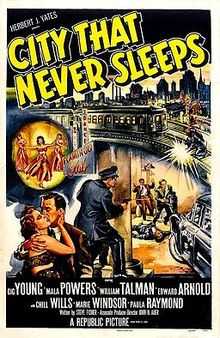City That Never Sleeps
- This article is about a 1953 film. For other uses, see The City That Never Sleeps (disambiguation).
| City That Never Sleeps | |
|---|---|
 Theatrical release poster | |
| Directed by | John H. Auer |
| Produced by | John H. Auer |
| Screenplay by | Steve Fisher |
| Starring |
Gig Young Mala Powers William Talman |
| Music by | R. Dale Butts |
| Cinematography | John L. Russell |
| Edited by | Fred Allen |
| Distributed by | Republic Pictures Corporation |
Release dates |
|
Running time | 90 minutes |
| Country | United States |
| Language | English |
City That Never Sleeps is a 1953 film noir produced and directed by John H. Auer with cinematography by John L. Russell.[1]
Plot
Johnny Kelly (Gig Young) is a Chicago cop from a long line of police officers. He's grown tired of the job and his married life. He plans on leaving his wife for exotic dancer Sally "Angel Face" Connors (Mala Powers). When Penrod Biddel (Edward Arnold), a corrupt, powerful attorney, wants him for a job, Johnny is tempted. He needs money in order to make a quick escape from Chicago and start life anew with "Angel Face".
Kelly accepts an assignment to escort a low-life former magician (William Talman), now a criminal, across the border to Indiana. Not all is what it seems and the more Kelly learns the more he's determined to do right.
Cast
- Gig Young as Johnny Kelly
- Mala Powers as Sally 'Angel Face' Connors
- William Talman as Hayes Stewart
- Edward Arnold as Penrod Biddel
- Chill Wills as Sgt. Joe, the 'Voice of Chicago'
- Marie Windsor as Lydia Biddel
- Paula Raymond as Kathy Kelly
- Otto Hulett as Sgt. John 'Pop' Kelly Sr.
- Wally Cassell as Gregg Warren
- Ron Hagerthy as Stubby Kelly
- James Andelin as Lt. Parker
- Tom Poston as Detective
- Bunny Kacher as Agnes DuBois
Reception
Critical response
Film critic Craig Butler wrote, "City That Never Sleeps is an uneven crime drama, one that contains some enough good elements that it's frustrating the film as a whole is not better. The chief culprit is, as so often, the screenplay, which starts out promisingly. Gig Young's character seems to be one that is fairly complex, a cop who is dissatisfied with his lot in life and could fall prey to temptation. Unfortunately, the character is not developed sufficiently beyond that, which is also the case with the Wally Cassell "mechanical man" character; he, too, shows promise that goes unfulfilled, although the sheer strangeness of his job does fascinate.[2]
The staff at Variety magazine gave the film a mixed review, and wrote, "Production and direction loses itself occasionally in stretching for mood and nuances, whereas a straightline cops-and-robbers action flavor would have been more appropriate. Same flaw is found in the Steve Fisher screen original...John L. Russell's photography makes okay use of Chicago streets and buildings for the low-key, night-life effect required to back the melodrama.[3]
References
- ↑ City That Never Sleeps at the Internet Movie Database.
- ↑ Butler, Craig. Film review at City That Never Sleeps at AllMovie. Last accessed: November 26, 2009.
- ↑ Variety. Film review, August 7, 1953. Last accessed: November 26, 2009.
External links
- City That Never Sleeps at the Internet Movie Database
- City That Never Sleeps at AllMovie
- City That Never Sleeps at the TCM Movie Database
- City That Never Sleeps film clip on YouTube
| ||||||